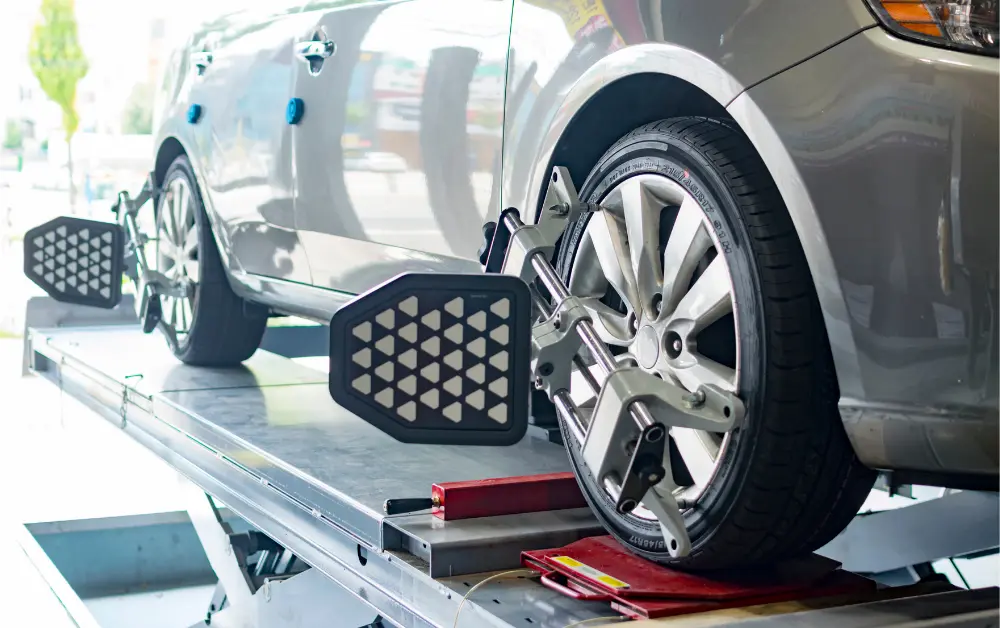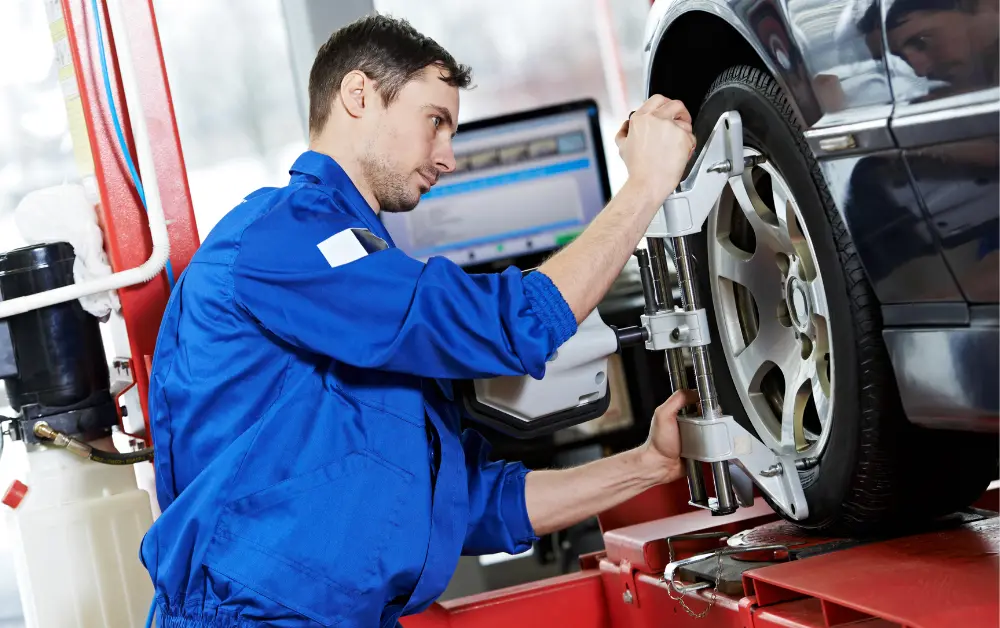A lousy car wheel can be a frustrating experience that affects your vehicle’s overall performance and safety.
Driving a car with bad alignment can lead to many problems, including decreased fuel efficiency, uneven tire wear, and poor handling. In some cases, bad alignment can even lead to accidents on the road.
In this comprehensive blog post, we’ll explain the causes and symptoms of bad alignment and provide tips on getting your car back on track.
Whether a car enthusiast or a casual driver, understanding the importance of proper alignment can help you avoid costly repairs and keep you safe behind the wheel.
What Exactly is Wheel Alignment in a Car?
Wheel alignment refers to adjusting a vehicle’s suspension components to ensure that the wheels are properly aligned with each other and the road.
Proper alignment ensures that your tires make even contact with the road, resulting in optimal handling, tire wear, and fuel efficiency.
Importance of Car Wheel Alignment
Car wheel alignment, also known as tire or suspension alignment, is a crucial aspect of vehicle maintenance. Proper wheel alignment ensures that your vehicle’s wheels are set to the optimal position in relation to the car’s suspension system and each other.
Proper wheel alignment helps to provide a comfortable, safe, and efficient driving experience. There are several reasons why car wheel alignment is essential:
- Proper alignment ensures that your car’s wheels are at the right angle to the road, which allows for smoother and more precise steering and results in better control, especially during turns and driving at high speeds.
- Proper alignment helps distribute the vehicle’s weight evenly across all four tires, prolonging their lifespan and saving you money in the long run.
- It helps to ensure that your car remains stable and responsive, allowing you to react quickly to potential hazards on the road.
- Regular alignment checks and adjustments can prevent damage to these components and keep your vehicle running smoothly.
- It helps in a smoother and more enjoyable ride.

Driving A Car With Bad Alignment- Consequences
1) Uneven Tire Wear
Misaligned wheels cause tires to wear unevenly and can also lead to Tire squealing, leading to a reduced lifespan for your tires which can result in you having to replace them more frequently, which can be costly.
2) Poor Fuel Efficiency
When your wheels are not correctly aligned, your engine has to work harder to move the vehicle, leading to decreased fuel efficiency.
This means you will need to fill your gas tank more often, costing you more money in the long run.
3) Reduced Handling and Control
Poor alignment can affect your vehicle’s steering, making it harder to control and less responsive and can be especially dangerous when driving in wet or slippery conditions, as it increases the risk of accidents.
4) Increased Suspension Wear
Wheel misalignment strain your vehicle’s suspension system and can lead to accelerated wear of suspension components, such as bushings, shocks, and struts, resulting in a need for more frequent repairs and replacements.
5) Vibration and Noise
Driving car with bad alignment can cause your car to vibrate or make unusual noises, especially at higher speeds. These vibrations and noises can irritate and distract while driving and may also indicate other underlying issues.
6) Compromised Safety
Poor alignment can affect the overall safety of your vehicle. Reduced handling and control, increased risk of tire blowouts, and compromised suspension can all increase the likelihood of accidents and put you and your passengers at risk.
7) Premature Wear of Other Components
wheel misalignment can also cause increased wear on other parts of your vehicle, such as the brakes, wheel bearings, and axle, and lead to more frequent repairs and higher maintenance costs.
8) Decreased Overall Vehicle Performance
In addition to the issues mentioned above, driving with lousy alignment can negatively impact your car’s overall performance and can make your vehicle feel less responsive, sluggish, and less enjoyable.

Warning Signs of Bad Wheel Alignment
Several warning signs can indicate bad tire alignment in your vehicle. Knowing these signs is essential to address the issue promptly and maintain your car’s safety and performance.
Here are some common warning signs of bad wheel alignment:
1) Tires Wearing Out Unevenly
If your tires are wearing unevenly, with some areas of the tire showing more wear than others, this can indicate misaligned wheels.
If you notice uneven tire wear or an uneven steering wheel, it’s a sign of compromised wheel alignment.
2) Steering Wheel Is Off-Center
If your steering wheel appears off-center, meaning it is not straight when driving straight, it could be a sign of bad alignment.
3) Vehicle Pulling To One Side
If your vehicle consistently pulls to one side while driving on a level road, it may result from poor wheel alignment. This can be especially noticeable when you release the steering wheel, and the car drifts to one side.
4) Vibration In The Steering Wheel
A vibrating steering wheel can indicate several issues, including lousy alignment. If you feel vibrations while driving, especially at higher speeds, checking your alignment is a good idea.
5) The Steering Feels Loose or Unresponsive
If your steering feels loose or less responsive than usual, it could be a sign of compromised wheels alignment and make controlling your vehicle more difficult, particularly in wet or slippery conditions.
6) Squealing or Abnormal Noises
If you hear squealing or unusual noises from your tires while driving, it may be due to bad alignment. This can happen because the tires are not even touching the road surface.
7) Rapid or Premature Tire Wear
If your tires are wearing out faster than they should be, it may indicate poor alignment. Regularly inspect your vehicle tires for signs of wear and have your alignment checked if you suspect an issue.
8) Car Pulls to One Side While Driving
Improper wheel alignment is one of the primary reasons a car might pull to one side. Misaligned wheels can cause your vehicle to drift to one side, even on a straight and level road.
9) Constant Steering Wheel Vibration While Driving
If you observe your steering wheel is constantly vibrating, or off-center steering wheel it can be a sign of bad wheel alignment.

You May Also Like To Read:
Common Causes of Bad Wheel Alignment
Several factors can lead to bad wheel alignment in a vehicle. Identifying and addressing these causes is essential for maintaining your car’s safety, performance, and overall driving experience.
Below are some common causes of bad tire alignment:
- Over time, the components of your vehicle’s suspension and steering system can wear down, leading to changes in the alignment.
- Driving over potholes, rough roads, or hitting curbs can cause damage to your vehicle’s suspension and steering components, which can result in bad alignments. It’s essential to drive carefully and avoid such obstacles when possible.
- Any accident or collision, even minor ones, can cause damage to your vehicle’s suspension and steering system. This damage can lead to poor wheel alignment and should be inspected and repaired by a professional mechanic.
- Worn or damaged suspension components, such as ball joints, tie rod ends, or bushings, can cause your wheels to become misaligned. Regular inspection and replacement of these components can help prevent alignment issues.
- If any part of your vehicle’s suspension or steering system needs to be installed correctly, it can lead to misaligned wheels. It’s crucial to ensure that a professional mechanic carries out any repairs or replacements to avoid this issue.
- Modifying your vehicle’s height by installing aftermarket suspension components, such as lowering springs or lift kits, can affect the alignment. If you make any changes to your vehicle’s height, it’s essential to have your alignment checked and adjusted accordingly.
- Carrying heavy loads or towing can stress your vehicle’s suspension more, leading to alignment issues over time. Ensure that your car is not overloaded and that any towing is done within the manufacturer’s recommended limits.
Why Fixing Bad Alignment Right Away Is Important.
Fixing bad alignment right away is important for several reasons, including safety, performance, and cost-effectiveness.
Poor wheel alignment can compromise your vehicle’s handling and control, making it more difficult to navigate and increases the risk of accidents. Misaligned wheels can also lead to uneven tire wear, which reduces the lifespan of your tires and may result in the need for premature replacements.
Furthermore, bad alignment can decrease fuel efficiency, causing you to spend more on gas in the long run. It can also strain your vehicle’s suspension system, leading to accelerated wear of components like bushings, shocks, and struts.
This can result in more frequent repairs and higher maintenance costs. Ultimately, addressing bad alignment promptly can help ensure your vehicle remains safe, performs optimally, and minimizes long-term expenses.
Tips to Keep Your Wheel Aligned
- Have your alignment inspected by a professional mechanic annually or according to your vehicle manufacturer’s recommended intervals.
- Regularly check your tire pressure and keep them inflated according to the manufacturer’s specifications.
- Rotate your tires as recommended by the vehicle manufacturer, usually, every 5,000 to 8,000 miles, to promote even tire wear.
- Avoid hitting potholes, curbs, or other obstacles that can cause damage to your suspension and steering components, leading to alignment issues.
- Be aware of any unusual symptoms, such as vibrations, pulling to one side, or uneven tire wear, which may indicate alignment problems.
- Regularly inspect your vehicle’s suspension system and replace any worn or damaged parts to maintain proper alignment.
- Ensure a qualified mechanic carries out any repairs or modifications to your vehicle’s suspension or steering systems to avoid incorrect installation that could affect alignment.
- Avoid carrying heavy loads or towing excessively, as this can strain your suspension and lead to alignment issues.

FAQ
How Much Does It Cost to Fix Alignment?
The cost to fix alignment can vary depending on the vehicle make and model, location, and whether you need a two-wheel or four-wheel alignment.
Generally, the price ranges from $50 to $150. It’s important to check with your local auto repair shop for accurate pricing.
Do I Need Proper Wheel Alignment?
Yes, proper wheel alignment is essential for maintaining your vehicle’s safety, performance, and longevity. It helps ensure optimal handling and control, even tire wear, and improved fuel efficiency.
How Is Bad Wheel Alignment Fixed?
Bad wheel alignment is fixed by adjusting the vehicle’s suspension components, such as the camber, caster, and toe angles, to bring the wheels back into proper alignment.
This process is performed by a professional mechanic using specialized equipment, such as an alignment machine and computer software.
Are There DIY Alignment Fixes I Can Do?
While there are some DIY alignment methods, such as using string or a level, these are only recommended for some drivers. Professional alignment services use advanced equipment and techniques to ensure accurate adjustments.
It’s best to rely on a qualified mechanic for alignment services to ensure your vehicle’s safety and performance.
Is Steering Pull Can Also Be Caused by Road Conditions?
Yes, steering pull can be caused by road conditions, such as uneven road surfaces or a sloping roadway. However, if your vehicle consistently pulls to one side, even on level roads, it’s essential to have your alignment checked to rule out any underlying issues.
What Is Your Technician Looking for During an Alignment Service?
During an alignment service, a technician will inspect your vehicle’s suspension and steering components for signs of wear or damage.
They will also measure your wheels’ camber, caster, and toe angles and adjust them as necessary to achieve proper alignment. They may also check and modify your tire pressure and perform a test drive to ensure that the alignment is accurate, and that the vehicle handles correctly.
Affiliate Disclosure: Cars Escort is a participant in the Amazon Services LLC Associates Program. As an Amazon Associate, we earn from qualifying purchases made through affiliate links on our site. Read Our Disclaimer .

